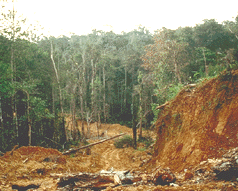Wind power is a complicated electricity source to evaluate for cost and GHG emissions. Most current estimates ignore the financial and GHG costs of intermittency.
Analysis by Joseph F. DeCarolis and David W. Keith (2006). The Economics of Large Scale Wind Power in a Carbon Constrained World.
If serious efforts are made to slow climate change, then the US electric sector will likely need to cut CO2 emissions in half within the next quarter century. Despite assertions to the contrary (NREL, 2002; UCS, 2003), wind is unlikely to become a competitive means to achieve reductions in air pollution or to enhance energy security. If air pollution reduction is the goal, then deep reductions in air pollutants can be achieved by retrofits to existing coal facilities at costs of order 1 ¢/kWh (Rubin et al., 1997). If energy security is the driving concern, then for many nations, coal provides sufficient security. The reserve/production ratio for coal is about 200 years globally, and 250 years in the US (BP, 2003).
The electric sector will deliver deeper cuts in GHG than other sectors, because it’s technically easier and because it’s easier to target centralized ownership and management. Reducing GHG emissions is windâ’s main advantage.
Summary first:
At a high GHG tax ($500/metric tonne C, $125/ton carbon dioxide), wind power in 2030 can supply up to 70% of electricity (getting that many windmills up and operating, and grid enhancements, by 2030 would be very hard), at a cost of 5 – 5.5 ¢/kWh. The majority of this will be the cost of dealing with intermittency. Distributing wind power over long distances gets the wind from where it is blowing (Great Plains) to where it is needed and averages it out. It is a better choice for high wind use than CAES (see below).
Details:
Changing demand helps. Effective methods include letting utilities reduce electricity to refrigerators (for example) parts of the day, and working with commercial and industrial customers on their energy use pattern on a day-by-day basis.

Demand Response Technology reduces demand at peak use hours. It can also reduce demand on low-wind days.
In 2002, there was over 32 GW wind capacity worldwide, at an average cost from 4 – 6 ¢/kWh at good sites. Within two decades, this price may drop to 2 ¢/kWh. Within a few decades, wind might supply 10 – 20% of electricity regionally or worldwide. Wind resources, however, are mismatched temporarily (wind doesn’t always blow, especially when most needed) and spatially (very windy sites are either popular for recreation or far from transmission lines). National Renewable Energy Laboratory estimates that in the next 50 years, [US?] wind power could reach several hundred GW (1,600 GW wind is needed to supply today’s electricity).
What if the use of wind does increase rapidly enough to provide one third or more of electricity? How much will this cost, and what problems need to be solved?
Several problems. Utility operators need to use a minute-to-minute method to balance electricity made with electricity taken from the grid. Backup capacity must exist to deal with days forecast for slow wind, and there must be some backup capacity capable of dealing with hourly changes in plans. Inefficient fossil fuel plants, and hydroelectric, are the most common backup, as it doesn’t make sense to use costly efficient natural gas plants.
The costs of dealing with intermittency aren’t well known when wind is a major contributor; the Danish and German models don’t apply because those wind plants are part of the European grid. The existence of several types of wind subsidies and other reasons makes wind costs difficult to calculate, but hour-to-hour and minute-to-minute variations add up to 0.3 ¢/kWh to the cost of wind power.
Wind blows a lot of some days, not so much on most days, and many days hardly at all. Intermittency affects cost today because it cuts into reserve power. Handling intermittency is a central issue of ramping wind supply up to high levels.
A second challenge is that the wind either doesn’t blow close to the grid or blows in areas where public opposition is likely. Wind power will have to be schlepped long distances from high quality wind sites. In the US, this means most wind power would be delivered from the Great Plains to the coasts. Wind intermittency is reduced when windmills are extended over several hundred miles. In addition to tangling out regulatory issues, there would be a cost for all those high voltage lines.
Storing Wind Energy
The alternative is storing the energy. There are two ways to store wind energy with low capital costs: pumping water uphill and using it later (limited to a few parts of the US), and compressed air energy storage (CAES, possible over 90% of the US). Other ideas such as batteries, flywheels, capacitors, are too expensive or designed for storage for less than an hour.

A large water pump storage power generation station is now under construction near the Kizyou town, Miyazaki Prefecture of Japan.
CAES stores air at 80 times atmospheric pressure in salt caverns, abandoned mines, etc. Excess wind-generated electricity runs the compressor. The compressed air is now available for heating, mixing with natural gas, and burning – the combination uses about half as much natural gas as would be needed if natural gas alone were used. Facilities would have to be much larger than those operating today to supply enough energy over the days of calm that can accompany a heat wave.
Back to long distance transmission
Long distance transmission is a lower GHG emissions option when wind power is significant.
When carbon taxes rise to $140/metric tonne carbon ($35/ton carbon dioxide), wind plus natural gas backup plus transmissions lines can compete as an electricity source. When the tax rises to $500/tC ($125/ton carbon dioxide), CAES makes sense. At several hundred dollars/tC, transmission lines over long distances come in. It does not make sense to use both long distance HV lines and CAES, as some of the benefit of storage is lost. At $500/tC, the cost of wind power is in the 5 – 5.5 cent/kWh range, about 2 cents of which is for the windmill.
An even higher tax does not benefit wind, because so much wind is wasted when the supply exceeds demand, and because backup must be used when there is no wind, no matter how high the cap. So wind will contribute at most 70% of electricity (with the rest natural gas and hydroelectric?).
Editorial comments:
One cent/kWh above today’s costs is fairly cheap.
If 70% of electricity comes from wind power (close to impossible in 2030), and 30% from natural gas, then GHG emissions/kWh in the US (50% coal, 22% petroleum plus natural gas) will decline by three fourths. If I understand this correctly, then this result would be good for 2030, but not for 2050. Where hydroelectric power provides backup, the reduction will be more impressive. (Hydroelectric power may be more problematic in western states in years to come.)
If wind power is less than 70% of the mix, then upgrading the grid won’t be so important — a smaller area will supply the wind power, and wind will supply less than 70% of wind + backup. If natural gas is backup, the reduction in GHG emissions will be less impressive.
In France, switching to wind power would increase GHG emissions.
For a much more optimistic take on wind power, see the link provided in a comment to the post on Socolow wedges.















